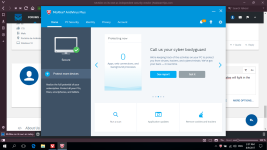- Oct 23, 2012
- 12,527
Source: McAfee on its own as independent security vendor
Effective today, McAfee has officially spun out from Intel, dumping the name Intel Security and operating under new majority ownership that has deep pockets to help the company aggressively acquire technology via mergers and acquisitions to supplement home-grown innovations.
Investment firm TPG is making a $1.1 billion equity investment in McAfee in return for 51% ownership, giving it the cash it needs to buy companies for their technology so it can be incorporated faster into McAfee platforms than if developed via R&D.
That’s a different strategy than is used by Intel in its chip business. “Identifying what it takes to run a semiconductor company is quite different from running a cybersecurity company in a rapidly changing threat landscape,” says Intel Security’s CTO Steve Grobman.
Effective today, McAfee has officially spun out from Intel, dumping the name Intel Security and operating under new majority ownership that has deep pockets to help the company aggressively acquire technology via mergers and acquisitions to supplement home-grown innovations.
Investment firm TPG is making a $1.1 billion equity investment in McAfee in return for 51% ownership, giving it the cash it needs to buy companies for their technology so it can be incorporated faster into McAfee platforms than if developed via R&D.
That’s a different strategy than is used by Intel in its chip business. “Identifying what it takes to run a semiconductor company is quite different from running a cybersecurity company in a rapidly changing threat landscape,” says Intel Security’s CTO Steve Grobman.
Now McAfee won’t be hindered by that philosophy and won’t have to compete with the chip side of the business for investment money, he says.
Key to McAfee’s strategy going forward will be to enhance its security fabric, what it calls Data Exchange Layer for security messaging that allows a range of security products to communicate. That includes McAfee’s own products as well as some of its partners including Aruba, Check Point Software and Rapid7.
That could include other vendors who make their products compatible on their own initiative by using the software developers kit the company open-sourced last November. It could also include integrations from researchers and customers, he says.
Going forward security needs to focus on the cloud and the endpoint. “Rather than a single technology we need to push our platform to set up a pipeline of technologies that we flow into our platform,” Grobman says.
Behind all this optimism lies the reality that Intel Security fell behind its SIEM competitors, says Joseph Blankenship, an analyst with Forrester. He says the most recent version has a new user interface and incorporates user behavior analytics and new automation capabilities via partnerships with vendors in those areas.
He says Forrester is cautiously optimistic about the effects the new ownership of McAfee will have on its products and the benefits they will have for customers.
Under the Intel Security name, the company made some false starts with the purchase of Stonesoft, and it got out of the email security business, he says, leaving some customers stranded.
Now the company seems to have a solid road map for its SIEM, but the key is how it will execute on that road map. “Really examine what you are being told and hold them accountable,” Blankenship says.


